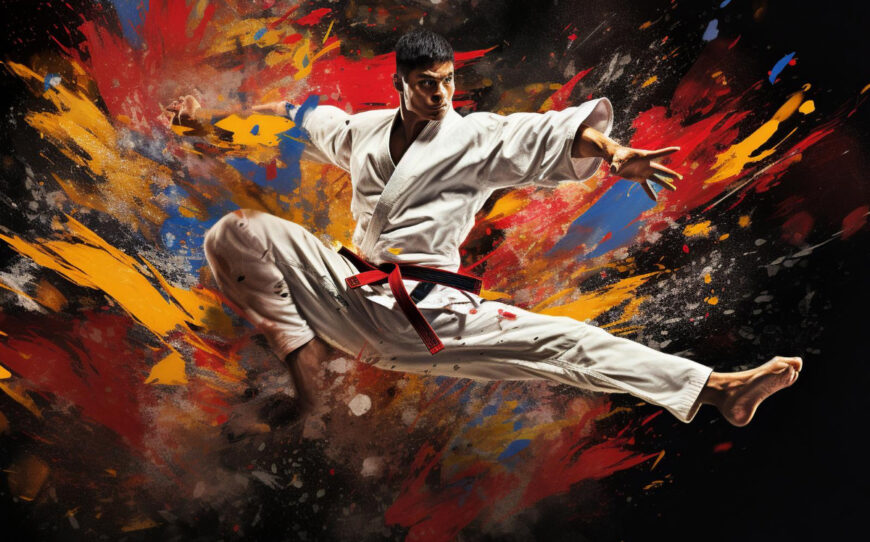Mastering Taekwondo, a revered Korean martial art, begins with understanding its basic forms. Essential building blocks for students of all skill levels, these choreographed movements provide a solid foundation. Additionally, it helps develop discipline and physical fitness in martial arts enthusiasts.
Whether you’re new to Taekwondo or an MMA fan looking to improve your techniques, this blog will walk you through the key components of basic Taekwondo forms. Besides, highlighting their significance in achieving mastery.
Key Takeaways
- Taekwondo forms, or patterns or poomsae, are a series of movements that simulate a fight. They are essential for muscle memory, accuracy, precision, balance, flexibility, and focus.
- Taegeuk and Palgwae forms offer unique benefits for martial arts enthusiasts looking to excel in Taekwondo. They can showcase their prowess in self-defense techniques while enhancing overall physical fitness.
- Practicing basic Taekwondo forms helps students improve their balance, coordination, concentration, and power. It promotes discipline and boosts self-confidence. Regular practice with guidance from qualified instructors helps master these techniques.
Understanding Taekwondo Forms
Taekwondo forms, or patterns or poomsae, are a series of movements that simulate a fight. Also, they are an essential aspect of martial arts training.
Definition And Purpose
Taekwondo forms serve as a fundamental component in Korean martial arts. These forms comprise a series of choreographed movements that simulate various self-defense techniques and offensive strikes.
The practice of Taekwondo forms allows students to apply the basic techniques learned during training within a structured sequence against imaginary opponents. Moreover, this methodical approach fosters improved physical fitness, instills discipline, and cultivates mental fortitude in practitioners.
Different Types Of Taekwondo Forms (Taegeuk Forms, Palgwae Forms)
Taekwondo offers various forms and help students develop their skills. Let’s focus on two main types: Taegeuk and Palgwae forms. These distinctive form types are designed for different levels of expertise and cover various techniques essential to any martial artist’s repertoire.
Taegeuk Forms:
- Represent the eight trigrams of the I Ching, an ancient Chinese book on divination.
- Designed primarily for color belt practitioners.
- Focuses on basic techniques according to geup grades (rankings).
- Progressively more complex as students advance from one form to another.
- Excellent for developing flexibility, strength, coordination, and balance.
Palgwae Forms:
- Based on the Korean flag’s eight trigrams and represents elements like heaven, lake, fire, thunder, wind, water, mountain, and earth.
- Typically taught to advanced students or black belts. It demonstrates an in-depth understanding of Taekwondo principles.
- Emphasizes fluidity in motion and mastery of advanced techniques.
- Enhances mental concentration and physical prowess through intricate combinations.
- It is steeped in traditional philosophy and symbolism and represents historical events or heroic figures.
Both Taegeuk and Palgwae forms offer unique benefits for martial arts enthusiasts. It helps them excel in Taekwondo and showcase their prowess in self-defense techniques.
Taekwondo Forms With Korean Name
Taekwondo forms have specific Korean names that represent their unique movements and meanings.
Il Jang
Il Jang is the first of the Taegeuk forms in Taekwondo and holds significant importance for beginners. It is because it introduces martial arts training.
It comprises 18 movements, focusing on basic stances like front stance and horse riding stance. Also, it emphasizes two fundamental hand techniques – the low block (Arae-Makgi) and the middle punch (Momtong-Jireugi).
For martial arts enthusiasts looking to master Il Jang, deliberate practice is essential. Because it builds a strong foundation before progressing through more advanced forms.
Repeating this form during regular training sessions refines their balance, coordination, and focus. Students should seek timely guidance from qualified instructors because they provide constructive feedback on technique execution.
Aspiring practitioners may also benefit from watching instructional videos. They can also attend workshops on Il Jang performance optimization.
Ee Jang
Ee Jang is the second Taekwondo form taught to color belt students. It consists of 27 movements and focuses on various kicks, blocks, and strikes.
The name Ee Jang means “joyful” or “harmonious,” reflecting its movements’ fluid and smooth flow.
Practicing Ee Jang helps students improve their balance, flexibility, and coordination. It also builds strength in their legs and core muscles. It allows them to better understand fundamental techniques like front kick, sidekick, inward block, outward block, and low stance.
Sam Jang
Sam Jang is a Taekwondo form that translates to “three steps.” It’s typically taught at the green belt level and features 33 movements. The movements focus on the student’s balance, power, accuracy, and posture.
In Sam Jang, students perform techniques like inward blocks, knife hand strikes, front kicks, and side kicks. Furthermore, these techniques simulate a fight with an imaginary opponent while helping practitioners gain muscle memory for self-defense situations.
Mastering Sam Jang requires patience and dedication through consistent practice under the guidance of qualified instructors.
Sa Jang
Sa Jang is the fourth of the Taegeuk forms. It represents wind, symbolizing power and gentleness. It consists of 20 movements focusing on developing hand techniques like knife-hand strikes and low blocks.
Practicing Sa Jang helps students improve their agility, balance, and coordination while honing their combat skills. Understanding the meaning behind each movement helps martial arts enthusiasts better appreciate the art of Taekwondo. Because it deepens their knowledge of Korean culture.
Oh Jang
Oh Jang is a Taekwondo form that represents the geup grade of a blue belt. It consists of 20 movements and is focused on developing the student’s balance, flexibility, and control. The form starts with a left-hand block. It follows up with a front snap, side, and roundhouse kicks.
Practicing Oh Jang helps students improve their coordination between upper and lower-body techniques. Moreover as they progress through the movements in this form, students learn to maintain proper stance alignments. They also execute strong punches or powerful kicks.
Learning Taekwondo forms requires dedicated practice to build muscle memory gradually. Martial arts practitioners must take their time mastering these basic forms before attempting more complex ones.
Yuk Jang
Yuk Jang is the sixth Taekwondo form in the Taegeuk series. It is designed for blue belts who have mastered the previous forms. It consists of 34 movements and represents water, symbolizing integrity and flexibility.
In Yuk Jang, you will learn new hand techniques like inward blocks and double punches. Besides, it refines your kicks like front snap kicks and backspin hook kicks.
Focusing on every detail in this form is essential since it builds upon what you’ve learned earlier.
Chil Jang
Chil Jang is the seventh Taekwondo form, also known as Poomsae. It consists of 25 movements and is taught to green belt students. Chil Jang means “Seven Serenity” and symbolizes calmness, stability, and focus.
Practicing Chil Jang helps martial arts enthusiasts improve their balance, coordination, concentration, and power. It also challenges them to perform precise techniques while maintaining a relaxed mind.
Learning this form takes time and dedication but can be a rewarding experience.
Pal Jang
Pal Jang is the eighth and final Taegeuk series of Taekwondo forms. It consists of twenty-four movements built upon techniques learned in previous forms, like Kibon Hana and Chon-Ji.
Practicing Pal Jang helps students improve their balance, timing, power, and precision. They learn to incorporate more complex techniques like side kicks and jumping kicks.
While mastering Pal Jang can be challenging, it offers benefits beyond physical fitness. This form increases self-awareness, discipline, focus, confidence, and stress relief.
Kibon Hana
Kibon Hana is a basic Taekwondo form often taught to white belt students. It consists of 20 movements and includes various kicks and strikes. The form introduces fundamental techniques like blocks, punches, stances, and footwork.
Kibon Hana is essential for beginners in their training journey. It sets the foundation for more complex forms or patterns to come. It helps practitioners develop focus, balance, coordination, and flexibility while improving physical fitness.
Koryo
Koryo is a black belt Taekwondo form that consists of 26 movements. The name Koryo comes from the name of an ancient Korean dynasty. It symbolizes the spirit and strength of its people.
This form focuses on developing power, speed, balance, and flexibility. It is done through complex techniques like jumping, spinning, and knife hand strikes.
Learning Koryo can be challenging but is rewarding. It is one of the essential forms in the Taekwondo curriculum. Practicing this form improves focus and concentration while enhancing physical fitness.
Keumgang
Keumgang is a dynamic Taekwondo form and requires discipline, focus, and precision. This form consists of 33 movements and represents the “diamond,” symbolizing hardness and strength.
According to legend, Keumgang was named after a mountain in Korea known for its majestic beauty and strong foundation. Practicing this form helps martial artists improve their balance, flexibility, and technique. It helps them learn to fight against multiple attackers.
Not only does Keumgang challenge students physically, but it also encourages them to cultivate inner strength. It focuses on breathing techniques and mental preparedness.
Taebaek
Taebaek is one of the higher-level Taekwondo forms, typically learned after mastering beginner and intermediate forms. It consists of 29 movements and is often associated with the meaning “bright mountain,” symbolizing a place where light meets darkness.
Practicing Taebaek aids in developing advanced techniques such as jumping kicks, spinning kicks, and multiple strikes.
Learning Taekwondo forms can be challenging but rewarding for both physical fitness and mental discipline. Practicing exciting high-level forms like Taebaek adds an extra dimension to martial arts training, enhancing students’ abilities beyond the basics.
Pyongwon
Pyongwon is a Taekwondo form that translates to “plain or vast plain.” This form is generally practiced at the black belt level and consists of 37 movements.
The pattern focuses on stability, balance, and control. It requires precise techniques like punches, blocks, kicks, and jumps on an imaginary line in both directions.
As with all forms of Taekwondo, it’s essential to approach Pyongwon with intention. Seek guidance from your instructor or watch videos for inspiration as you work towards accuracy and precision.
Sipjin
Sipjin is a Taekwondo form that translates to “18,” corresponding to the number of movements in the pattern. It is taught at the third or fourth-degree black belt level and focuses on fluidity, power, and balance.
Sipjin incorporates various kicks, strikes, blocks, and stances. They simulate combat scenarios while showcasing advanced techniques of Taekwondo. Practicing Sipjin helps improve one’s precision, strength, speed, and mental discipline.
Jitae
Jitae is a black belt Taekwondo form that consists of 24 movements. It is designed to simulate a fight against multiple opponents. The emphasis is on rapid and powerful strikes with the fists and feet.
Practicing Jitae can improve balance, agility, speed, and power while enhancing mental focus and discipline. Mastering this form requires consistent practice with attention to small details. Proper breathing techniques and stances are two of them.
Cheonkwon
Cheonkwon is a black belt form in Taekwondo that translates to “heaven’s great power.” It consists of 30 movements and requires mastery of many advanced techniques.
Performing Cheonkwon requires a lot of mental focus, involving several jumping, spinning, and kicking techniques. Practicing Cheonkwon can benefit martial arts students in many ways. It improves speed, agility, coordination, and balance while enhancing physical fitness.
The form also emphasizes the importance of precision technique execution and mental fortitude. These are necessary for high-level competition success.
Hansu
Hansu is one of the black belt Taekwondo forms that requires significant mastery. It consists of 37 movements, representing a historical figure’s encounter with an attacker in a forest.
Learning Hansu challenges practitioners to refine their skills by developing greater control over their motions. It helps them accurately execute each move’s different components.
It also enhances focus and concentration skills needed for sparring or self-defense scenarios.
Ilyeo
Ilyeo, or “One Mind,” is a Taekwondo form incorporating a complex combination of kicks and strikes. High-level students and black belts typically practice this advanced form.
Ilyeo emphasizes the importance of unified movement and focus. It requires practitioners to execute each motion with precision and strength while maintaining mental clarity.
Students can consistently practice Ilyeo to improve their concentration, balance, and overall physical fitness. Besides, cultivating a deep sense of discipline and self-awareness.
Chon-Ji
Chon-Ji is a Taekwondo form commonly taught to white belt students as they begin their martial arts journey. The form consists of 19 movements. They symbolize the creation of the universe and the beginning of human history in Korean folklore.
One highlight of Chon-Ji is its emphasis on basic techniques, like blocks, punches, and kicks.
Learning Chon-Ji can be challenging for beginners, but it’s essential to mastering more complex forms. Students can gradually improve their skills by breaking each movement into manageable segments. Practicing with intention and consistency is key.
Read Also: Taekwondo Belt Levels And Ranking Guide
The Benefits of Practicing Taekwondo Forms
Practicing Taekwondo forms offers numerous benefits. It includes improved focus and physical fitness, increased self-confidence, and stress relief.
Improved Focus And Concentration
The regular practice of Taekwondo forms can significantly improve focus and concentration. As students must memorize the sequence of movements, they must be fully present in the moment to perform each technique correctly.
Mastering forms requires immense discipline and mental stamina. It hones one’s ability to concentrate and remain focused even under high-pressure situations.
Many practitioners find increased focus carries over into other areas of their lives, like work or school. It helps them stay on task more efficiently.
Enhanced Physical Fitness
Practicing Taekwondo forms offers a range of physical fitness benefits. Regularly performing these patterns improves cardiovascular health, muscular strength and endurance, and overall flexibility.
As students progress through the different levels, they may need to incorporate kicks and jumps. It requires greater agility and balance. Besides improving physical fitness levels, Taekwondo forms can also effectively burn calories and lose weight.
Increased Discipline and Self-confidence
Practicing Taekwondo forms can lead to an increase in discipline and self-confidence. These forms require great focus, attention to detail, and consistent practice.
Students develop a sense of discipline by dedicating themselves to learning and mastering these forms. They can apply it to other areas of their lives.
Students gain confidence in their skills as they progress through the belt system and perfect each form. They become more comfortable with basic techniques like kicks, punches, blocks, and stances. They learn how to execute them effectively.
This continuous improvement and dedication towards improving oneself through martial arts training increases discipline levels. It incorporates physical challenges and mental fortitude leading toward building strong character traits. Perseverance & determination, along with improving self-esteem. These are crucial for success inside and outside the dojo or ring!
Mastery of Fundamental Techniques
Mastery of fundamental techniques is a crucial benefit of practicing Taekwondo forms. Students learn and perfect basic moves like blocks, strikes, kicks, and stances by regularly practicing. These movements are vital in sparring and real-life self-defense situations.
Through mastering these techniques, practitioners gain increased confidence in their abilities. They are better equipped to defend themselves or others if necessary. Consistent practice leads to improved muscle memory and reflexes. It allows the student’s body to respond automatically when facing a threat.
Continual practice reinforces proper form, leading to more efficient and effective energy use during training sessions.
Mastery of fundamental techniques affects one’s fighting skills and general physical health. It introduces variations of execution for each technique gradually over time at various belt-level gradings. This is based on age-old principles that have stood the test of time across centuries until the present following historical documentation.
The success stories illustrated are related to this aspect alone – thus underlining its importance throughout history too!
Improved Balance And Flexibility
One of the essential benefits of practicing Taekwondo forms is enhanced balance and flexibility. As you progress through various skill levels, your body learns to move in new ways with precision and control.
These movements may include spins, jumps, kicks, and other techniques. With consistent practice, you will notice improved coordination between different body parts. It leads to a greater sense of physical harmony.
The stretching routines accompanying Taekwondo training help increase flexibility over time. This makes it easier for practitioners to execute complex movements.
Stress Relief
Besides the physical benefits of practicing Taekwondo forms, there are also significant mental and emotional benefits. One such benefit is stress relief.
The focus required to learn and perfect each movement in a form helps quiet the mind and provide a sense of calm.
Research has found that martial arts practices like Taekwondo can significantly reduce stress levels. It helps individuals regulate their emotions, improve mood, and increase mindfulness.
Regular Taekwondo practice allows individuals to release any pent-up frustration or anger. It leads to a more balanced mental state overall.
Increased Self-awareness
Students can develop a heightened sense of self-awareness through consistent practice of Taekwondo forms. This involves awareness of their body movements, breathing patterns, and mental state during training.
Increased self-awareness extends beyond the physical aspect of training to one’s mindset and emotional well-being. Practicing Taekwondo forms requires discipline and focus, which translates into an ability to control one’s thoughts and emotions in class and daily life.
This translates into better decision-making abilities when faced with challenging situations.
Tips For Mastering Taekwondo Forms
Practice consistently with intention, seek guidance from qualified instructors, and visualize the forms to improve your Taekwondo skills. Incorporating forms into your regular training regimen while focusing on individual movements helps you set achievable goals and enhance discipline.
Practice With Intention And Consistency
To truly master Taekwondo forms, practice with intention and consistency. This means setting specific goals for each session and working towards them with focus and determination.
It’s easy to simply go through the motions during practice, but this won’t lead to real progress. Consistency is also key when it comes to practicing Taekwondo forms. Regular training sessions help build muscle memory and reinforce good habits.
Aim for a consistent schedule that works for you – whether practicing every day or a few times weekly. And stick with it as much as possible.
Seek Guidance And Feedback From Qualified Instructors
Seek guidance and feedback from qualified instructors when practicing Taekwondo forms. Instructors can teach students the correct techniques and provide valuable feedback on how to improve their form.
Qualified instructors have years of experience and knowledge. It makes them an invaluable resource for anyone seeking to master Taekwondo forms. They can help you develop your skills, focus your mind, and perfect your technique.
They can guide you through the various difficulty levels as you progress through color and black belts in the curriculum.
Visualize And Mentally Rehearse The Forms
One of the most effective ways to master Taekwondo forms is through visualization and mental rehearsal. Visualizing each movement in your mind can improve muscle memory and enhance focus. It helps achieve a deeper understanding of the form’s techniques.
Many professional athletes, including martial artists, use visualization techniques to improve their performance. By imagining themselves performing flawless kicks, blocks, and strikes in their mind’s eye repeatedly, they start to develop a subconscious habit. It results in the execution of those moves correctly.
Incorporate Forms Into Your Regular Training Regimen
Incorporating Taekwondo forms into your regular training regimen is crucial to mastering the techniques. Regularly practicing these choreographed patterns will develop muscle memory, balance, and agility. Dedicate ample time to perfecting each movement within a form and not rush through them.
Practicing forms consistently can significantly impact cardiovascular health, flexibility, and coordination. Regular practice of Taekwondo forms enhances focus, discipline, and mental clarity while relieving stress.
Instructors may incorporate different teaching methods, like visualization techniques or partner drills. It helps students understand how the form applies in combat situations.
Focus On Individual Movements
To master Taekwondo forms, break down each movement and focus on perfecting them individually.
One common mistake is rushing through movements instead of focusing on each one.
Another tip is to use visualization techniques when practicing alone.
Mastering individual movements may be challenging initially, but it ultimately leads to better overall performance.
Set Achievable Goals
One of the keys to mastering Taekwondo forms is setting achievable goals. Beginners may feel overwhelmed by the number of movements and the complexity of the forms. Breaking them down into smaller, manageable goals builds confidence and motivation.
Remember that progress is personal and varies from person to person. Setting realistic goals based on individual skill level and experience is crucial for success in Taekwondo.
As students accomplish these smaller goals, they will gain momentum toward achieving their ultimate goal – mastery of the form.
Common Mistakes To Avoid When Practicing Taekwondo Forms
Avoid inaccurate movements, lack of focus, poor breathing technique, and failing to modify forms for injuries when practicing Taekwondo forms.
Inaccurate Movements
One of the common mistakes to avoid when practicing Taekwondo forms is making inaccurate movements. Each movement in a form has a specific purpose. Any deviation from that purpose can affect the overall effectiveness of the form.
To avoid this mistake, martial arts students should focus on each movement. Also, it ensures they perform it accurately before moving on to the next one.
Practicing Taekwondo forms with accuracy takes time and effort. Still, it is crucial for mastering fundamental techniques, improving focus, concentration, self-confidence, balance, flexibility, and reducing stress levels.
Lack of Focus
One of the most common mistakes practitioners make when practicing Taekwondo forms is a lack of focus. Concentrating on each movement and transition between them is essential. Even the smallest deviation can impact the entire form’s flow and effectiveness.
Practitioners must focus on breathing, body positioning, and technique throughout each practice session.
Students who consistently struggle with staying focused during training may find meditation techniques or specific breathing exercises like pranayama helpful. Moreover, it improves their concentration levels, ultimately enhancing their overall martial arts performance.
Poor Breathing Technique
Proper breathing is essential in martial arts. It affects performance and overall health. Poor breathing technique during Taekwondo forms can cause unnecessary tension and fatigue.
It’s common for beginners to hold their breath while performing movements. This can lead to decreased stamina and concentration.
Also, proper breathing can help with timing during moves requiring exertion or explosive power. Kicks or strikes are two of them. Inhaling before a move allows the body to gather sufficient air in preparation for an upcoming motion. Exhaling releases energy and facilitates movement.
To practice better breathing techniques, students should incorporate inhales and exhales seamlessly.
Modifications For Injuries
Injuries are an unfortunate reality of any physical activity, and Taekwondo is no exception. Moreover, practicing forms can put a significant strain on the body, especially for those who have pre-existing injuries.
One essential modification is adjusting the stance to alleviate pressure on injured joints or muscles. Therefore, if someone has a knee injury, they may need to widen their stance slightly and keep their weight more centered to avoid further damage.
Communicate with instructors about any injuries. They can help suggest appropriate modifications for specific moves within the form.
Learn More About Taekwondo
- Taekwondo Weapons To Try: From Nunchucks to Bo Staff
- Taekwondo Vs Karate: The Ultimate Showdown
- Taekwondo Kicks: Learn Everything About The Kicks In Taekwondo
- Top 10 Greatest Taekwondo Players of All Time
- Best Martial Arts for Streetfight: Unleash Your Inner Warrior
- Best Taekwondo Schools in the World
- Top 21 Deadliest Martial Arts in the World According to Experts
- Taekwondo Belt Levels and Ranking Guide
- Taekwondo Stances
FAQs
1. What Are Basic Taekwondo Forms?
Basic taekwondo forms are a series of movements. They include strikes, blocks, and kicks, performed in a specific sequence to develop muscle memory and technique.
2. How Many Basic Taekwondo Forms Are There?
Every beginner must learn eight basic taekwondo forms and progress further into the martial art.
3. Why Do Practitioners Need To Learn Basic Taekwondo Forms?
Learning basic taekwondo forms is essential for building strength, balance, coordination, and discipline. It teaches self-defense techniques that can be used outside training sessions or competitions.
4. Can I Perform Basic Taekwondo Forms Without An Instructor’s Guidance?
Attempting basic Taekwondo Forms without proper guidance from an experienced instructor is not recommended. It could lead to incorrect form execution, hindering effective progress in learning martial arts.
Conclusion
Taekwondo forms are crucial in developing martial arts skills. Understanding the purpose and different types of forms is essential for students to progress through the belt system.
Practicing these forms provides benefits like physical fitness, increased discipline, and self-confidence. To master these techniques, practicing consistently while seeking guidance from qualified instructors is important.
Avoid mistakes like inaccurate movements or poor breathing techniques for success.









